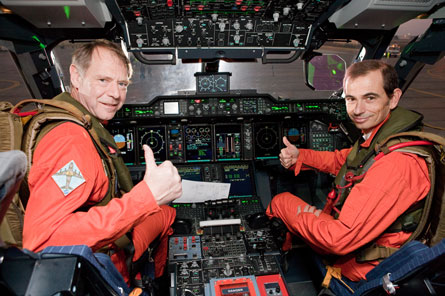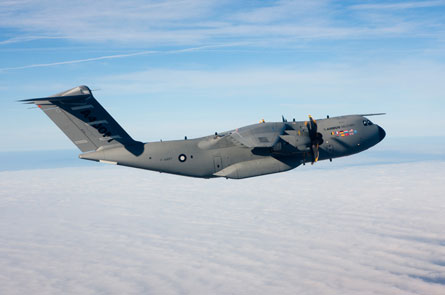Edward "Ed" Strongman is as cool, calm and collected as any industry test pilot you could hope to meet. But it seems that even he has struggled to completely detach himself from the surge of excitement that surrounded the maiden flight of the Airbus Military A400M, commanded by him on 11 December.
"I would say it's less emotional when it's a few days after the flight," says Strongman, Airbus's chief military test pilot.
 |
|---|
Ed Strongman (left) with his co-pilot |
A400M MSN001 departed San Pablo airport near Seville, Spain at a take-off weight of 127t, 14t below maximum, and was airborne for 3h 45min.
The departure was delayed by 15min due to problems with flight-test equipment used to modify flight control laws and to "pulse" flutter inputs to the control surfaces. "When we were actually in flight we lost probably another half an hour because we needed this system to be able to go into 'normal' law and to make our first flutter inputs to see how the aeroplane responded," Strongman says.
 |
|---|
A400M in flight |
After take-off the crew evaluated the four-engined airlifter's handling qualities in direct law, through all flap configurations from "clean" to "flaps 4".
"We looked in more detail in flaps 4 because that was our landing configuration, and went down to the stall-warning speed," Strongman says.
"In the clean configuration we expanded the envelope to maximum speed (VMO), which is 300kt (555km/h), and we did that both in direct flight control law and also in 'normal'," he adds.
"In direct law it was perfectly stable and easy to fly, and we did a large part of the flight in direct law because that's what we explore first to make sure there are no surprises in the envelope, and then we engage the normal law and explore the same range again.
"It was a great pleasure to see how well tuned normal law was from the beginning, but I don't want to be too enthusiastic because we have a lot of corners [of the envelope] to go into yet to make sure everything is fine."
These tests were performed at 8,000-10,000ft (2,440-3,050m), but the aircraft was taken as high as 18,000ft to confirm that "the pressurisation and all the systems were working for us to go to higher altitudes", says Strongman.
The landing gear was cycled a couple of times, during which unexpected buffet was experienced.
"There are some things that are very difficult to predict and one of them is the sort of buffet that you experience when you extend and retract the gear," says Strongman. "It's the sort of buffet that we've experienced on the A340 before and so we've got a box of tricks that we'll put on to overcome this," he adds.
Overall, Strongman is impressed with the A400M's flying qualities.
"The handling was as good as I'd hoped it was going to be from the simulator, because it's an aeroplane which is far more agile and manoeuvrable than a civil aeroplane," he says. "We have in some zones about twice the roll-rate, for example. It's much more precise and rapid than we're familiar with. It all looked good within the limits of what you can do on a first flight."
As is customary for a maiden flight, extra margin was added to approach speeds and there was "more than enough" control-surface authority for the flare, says Strongman.
The aircraft's Europrop International TP400 turboprop engines performed "fine" from maximum power down to idle and blade stresses were "as expected".
In the air and under normal control laws the operation of the propulsion system is largely transparent to the pilot, says Strongman. However, "once you're on the ground it's a whole new ball game because you need to make the transition from the flight range to the ground range, you have a different form of deceleration coming from the propellers than you do from reverse thrust, and obviously you have [an aircraft] reverse capability on top of that."
The A400M's cockpit introduces military-specific avionics, such as pilot head-up displays.
"We did everything using the HUD," says Strongman. "That was one of the military systems that was a real pleasure to use. We also used the digital map system."
MSN001 was due to fly for a second time on 19 December, weather permitting, during which Strongman expected to take the aircraft to an altitude of 30,000ft.
"One of the things that we really need to work on in the first month is to do as much as we can with the engines and propellers to be able to move away from this limitation where we've got an instrumented blade, so that we're not quite so restricted in terms of the weather that we can fly in," says Strongman.
Source: Flight International























